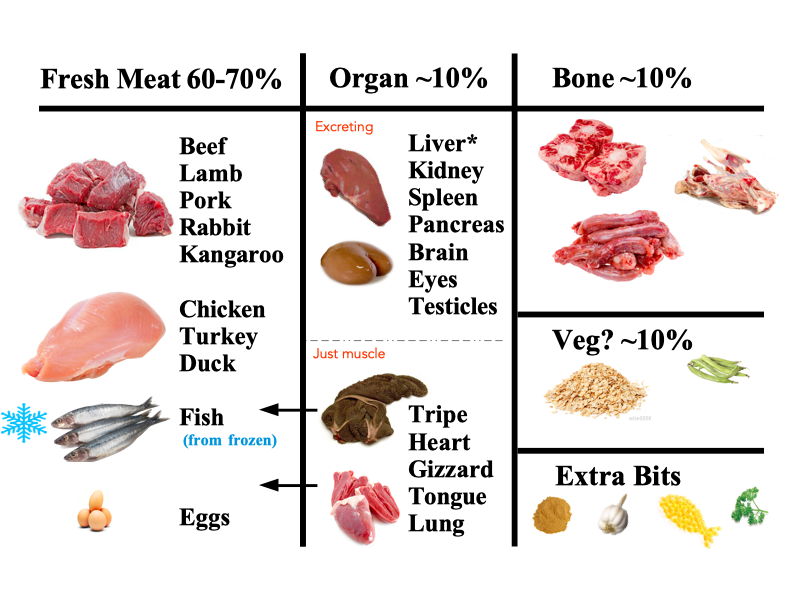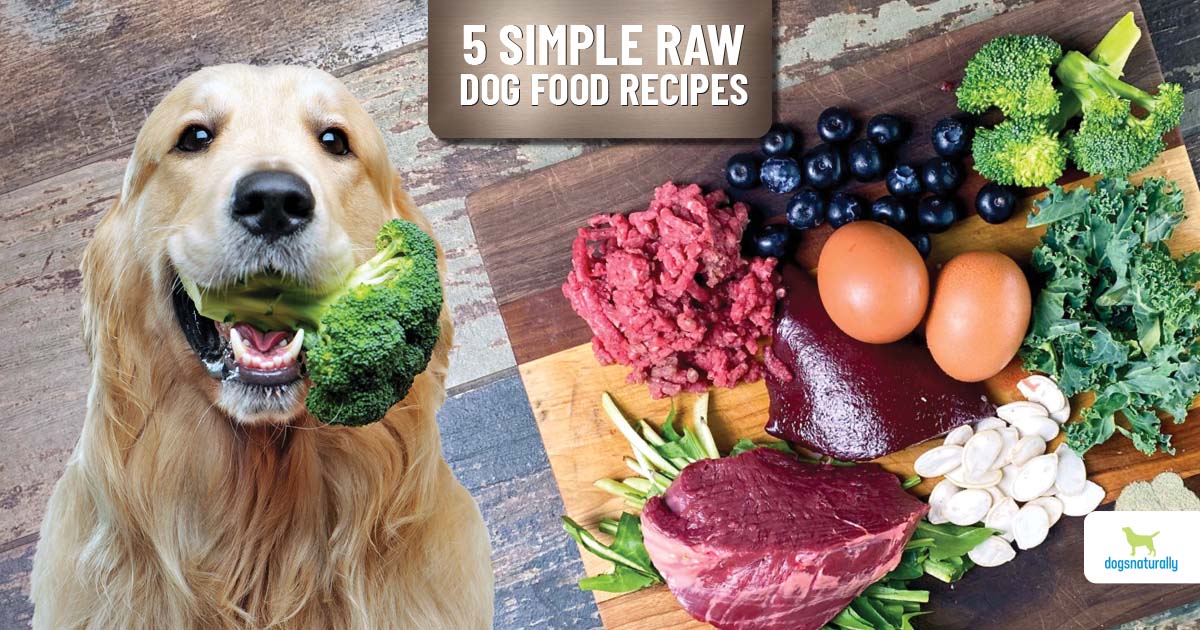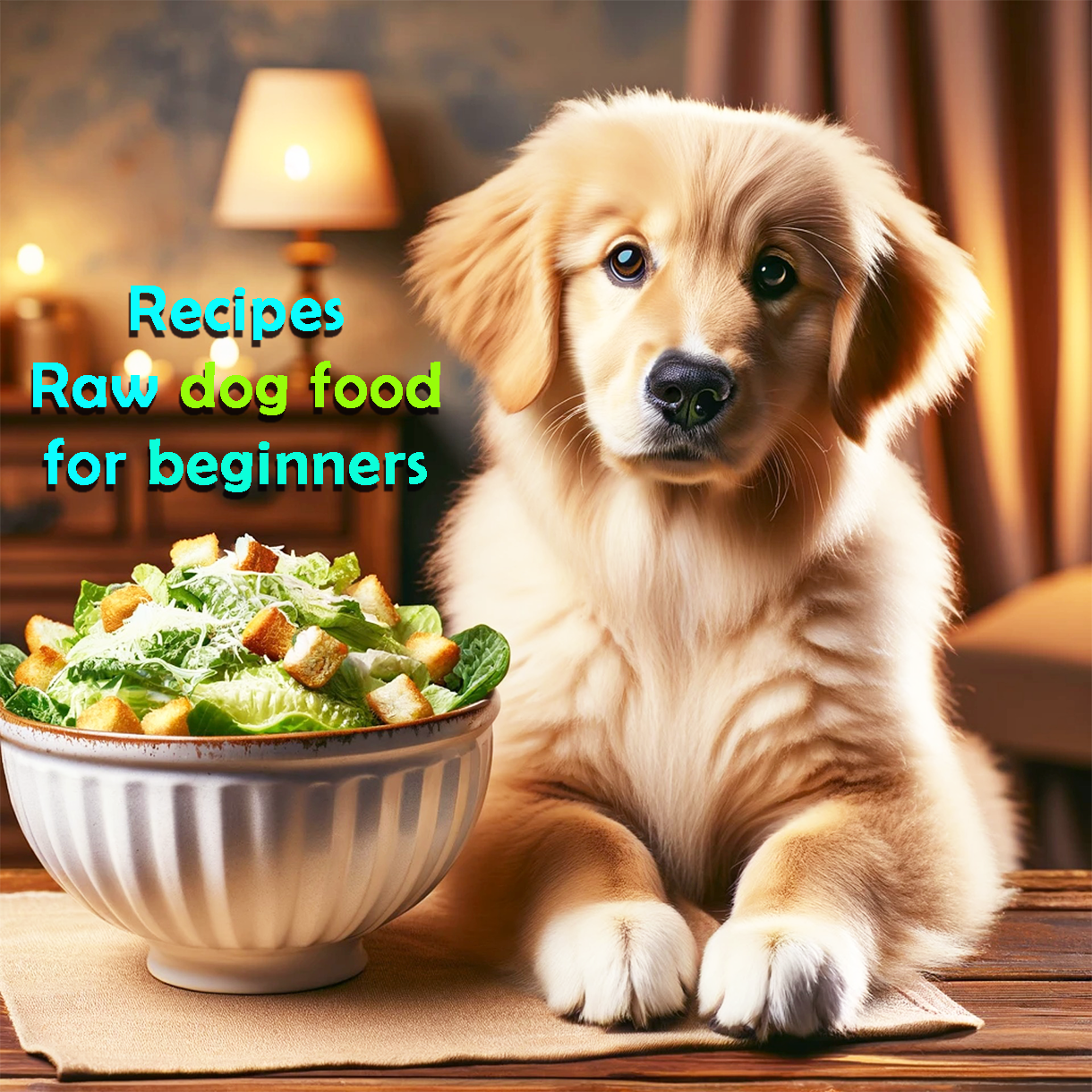Recipes Raw Dog Food for Beginners typically consist of balanced proportions of meat, bones, organs, and vegetables. Initial preparations involve choosing quality ingredients and understanding your dog’s nutritional needs.
Embarking on a raw food diet for your dog can be a health-conscious choice that may contribute to improved vitality and overall wellness. Crafting meals at home allows pet owners to tailor the diet to their dog’s particular requirements and preferences, ensuring a fresh, preservative-free feast.
While the switch to raw feeding often intimidates newbies, it’s manageable with some knowledge and preparation. You can make the transition smooth and secure by learning about proper food handling, essential nutrients, and portion sizes. Balancing the diet with the right variety of raw ingredients can achieve optimal health for your furry friend. Keep reading to discover simple recipes and tips to kick-start your journey into homemade raw dog food.

Credit: www.dogsfirst.ie
The Raw Dog Food Movement
The Raw Dog Food Movement is gaining momentum among pet owners seeking natural diet options for their furry companions. This dietary shift mirrors ancestral canine eating patterns, consisting of raw meats, bones, fruits, and vegetables. Advocates argue that this diet offers numerous health benefits that reflect a dog’s primal nutritional needs.
Origins And Philosophy
The philosophy behind raw dog food is that dogs should eat diets resembling those of their wild ancestors. It focuses on unprocessed and uncooked ingredients, sidelining commercial pet foods. Enthusiasts believe that a natural diet can lead to a healthier, more vibrant life for dogs.
- Bio-appropriate ingredients mimic wild diets.
- Raw food advocates credit the diet to increased energy.
- Immune systems strengthen on a natural diet.
Benefits And Controversies
The switch to raw dog food often comes with reported benefits. However, the topic isn’t without its controversies, sparking debates among vets and pet owners alike.
| Benefits | Controversies |
|---|---|
| Improved coat health | Risk of pathogens |
| Better dental hygiene | Nutritional imbalances |
| More energy | Concerns about bones |
Detailed discussions of raw diets evoke scrutiny. Critics voice concerns about the potential spread of bacteria and the hazards of choking on bones. Moreover, ensuring balanced nutrition for different dog breeds and life stages can pose a challenge for owners.

Credit: huskerlandbulldogs.com
Essential Nutrients For Dogs
Providing a balanced, raw diet to your dog is crucial. Dogs need specific nutrients to thrive. Understanding these essentials prepares you for raw feeding. Let’s explore the foundation of a dog’s nutritional needs.
Proteins And Fats
Proteins are the building blocks for dogs. They support muscle growth and repair. Raw meat is an excellent protein source. Include beef, chicken, lamb, and fish. Fats offer energy. They keep your dog’s coat shiny and healthy. Add fish oil or flaxseeds for omega-3 and omega-6 fatty acids.
Vitamins And Minerals
Dogs also need vitamins and minerals, which support their bones, teeth, and nerves. Raw diets usually provide these from fruits and vegetables. Leafy greens and berries are great options, as they contain antioxidants.
Balancing The Diet
Balancing your dog’s diet is vital. Aim for a mix of proteins, fats, vitamins, and minerals. Every meal doesn’t need to be complete, but weekly meals should be balanced. Use a variety of ingredients to meet different needs. Organ meats are important, too. They provide unique nutrients not found in muscle meat.
| Ingredient | Nutrient |
|---|---|
| Beef | Protein, Fats |
| Fish Oil | Omegas, Fats |
| Leafy Greens | Vitamins, Minerals |
| Berries | Antioxidants, Fibers |
| Organ Meats | Iron, Zinc |
- Proteins: Muscle meat, organs, eggs
- Fats: Animal fats, oils
- Vitamins: A, D, E, and K
- Minerals: Calcium, phosphorus, magnesium
- Select a variety of proteins.
- Use healthy fats.
- Mix different veggies and fruits.
- Include bone for calcium.
- Add organ meats weekly.
Setting Up For Success
Embarking on the raw dog food journey excites you and your puppy. To get started on the right paw, setting yourself up for success is crucial. Gathering the right kitchen tools and understanding the best practices for handling and storage will ensure a smooth transition to a raw diet for your furry friend. Let’s dig into the essentials that will make the preparation of raw dog food a breeze and keep it safe for consumption.
Kitchen Essentials
Being equipped with the appropriate tools is revolutionary. Let’s outline the must-haves:
- High-quality knives: Sharp and durable for cutting raw meats.
- Meat grinder: If you prefer to grind meat and bones.
- Cutting boards: Dedicated boards for raw meat to avoid cross-contamination.
- Digital scale: For precise meal portions.
- Storage containers: To keep prepared meals fresh.
- Large mixing bowl: For combining ingredients.
Handling And Storage Tips
Proper handling and storage are crucial for your dog’s safety. Keep these tips in mind:
- Both before and after handling raw food, wash your hands.
- Use separate utensils for raw dog food preparation.
- Thaw meat in the refrigerator and never at room temperature.
- Store raw food in airtight containers in the fridge or freezer.
- Discard uneaten food within 30 minutes to prevent spoilage.
- Sanitize surfaces after food prep to eliminate bacteria.
With these kitchen essentials and handling tips, you’ll create a safe and efficient environment for preparing your dog’s raw meals. Your dog depends on you for nutrition, so start strong with these foundations.
Simple Raw Food Recipes
Starting a raw food diet for your pup can seem daunting. Yet, simple recipes make the transition easier. Dogs thrive on diets that include raw meats, bones, and organs. These recipes ensure balanced nutrition for a happy, healthy dog. Let’s explore easy, beginner-friendly options for your furry friend.
Basic Meat And Bone Meals
Feeding raw starts with the basics: meat and bones. Bones provide calcium and support dental health. Meat offers essential proteins. Combine these for a nutritious meal. Remember to balance meat with bone at a ratio that suits your dog’s size and breed. (Tip: 10% bone is a good starting point.)
Recipe Example:
- 80% muscle meat (chicken, beef, or turkey)
- 10% edible bone (chicken wings or necks)
- 10% organs (liver and kidneys)
Variety Meat Mixes
Varying the diet is key to providing a spectrum of nutrients. Introduce different types of meat over time to ensure your dog gets a range of vitamins and amino acids.
Easy Mix Recipe:
- Mix different meats like lamb, pork, and fish.
- Add a variety of organs for a nutrient boost.
- Combine with a small portion of fruits or vegetables for fiber.
Remember to consult with a vet before starting a raw diet. Portion sizes depend on your dog’s weight, activity level, and health. These simple recipes offer a solid foundation for raw feeding beginners.
Adding Fruits And Vegetables
Don’t forget about fruits and veggies when building a balanced raw dog food diet. These plant-based options add vitamins, minerals, and fiber to your pup’s meals.
Safe Plant-based Ingredients
Fruits and vegetables should be a part of your dog’s diet. Here’s a quick guide:
- Carrots: Great for dental health.
- Apples (without seeds): Good for vitamins.
- Blueberries: Rich in antioxidants.
- Spinach: Offers iron and fiber.
- Pumpkin: Helps with digestion.
Preparing Plant Matter For Digestion
Dogs can’t break down plant cell walls as humans do. So, you need to prepare fruits and veggies to help them.
- Pureeing: Blends the plant matter into a digestible form.
- Steaming: Makes veggies softer without losing nutrients.
- Freezing: Preserves freshness and can be soothing for teething pups.
Remember to introduce new foods slowly and in small quantities to avoid stomach upsets.
Supplements And Superfoods
Welcome to the world of raw dog food diets, where your furry friend’s health is a top priority! While raw meals can offer your pup many benefits, it’s essential to recognize the role of supplements and superfoods. These additions ensure your dog gets a complete and balanced diet. Let’s explore the key ingredients that will supercharge your dog’s nutrition.
Key Supplements
Supplements can fill any nutritional gaps in your dog’s raw food diet. Essential supplements to consider include:
- Calcium: Critical for bone health.
- Fish Oil: Source of omega-3 fatty acids for coat and skin health.
- Vitamin E: An antioxidant for immune function.
- Joint Supplements: Like glucosamine, for aging dogs or breeds prone to joint issues.
Before introducing any supplement, consult your vet to tailor them to your dog’s needs.
Natural Superfoods For Dogs
Superfoods pack a punch of nutrients and can be a great addition to your dog’s raw diet. Consider the following superfoods for dogs:
| Superfood | Benefits |
|---|---|
| Pumpkin | High in fiber and vitamins. |
| Blueberries | Antioxidants for overall health. |
| Spinach | Rich in iron and vitamin K. |
| Sweet Potatoes | Vitamins A, C, and B6 for energy. |
Blend these natural ingredients into your dog’s raw meals for an extra health boost. Listen to your vet’s advice to ensure the best superfood choices for your pet.
Transitioning Your Dog To Raw
Shifting your furry friend to a raw diet could be a positive change. However, it’s a process that needs care. Let’s bark up the right tree!
Gradual Introduction
Switching foods quickly might upset your dog’s tummy. Start slow. Mix raw food with their current diet. Increase the raw portion over time. It’s like sneaking veggies into a kid’s meal!
- Day 1-3: Serve 25% raw with 75% old food.
- Day 4-6: Up the raw to 50%.
- Day 7-9: Go for 75% raw this time.
- Day 10: Aim for a 100% raw party in the bowl!
Monitoring Your Dog’s Health
Keep a close watch on your dog. Health changes can happen. Be ready to spot them.
| What to Check | Healthy Signs | Warning Signs |
|---|---|---|
| Energy Levels | More playful, active | Lethargic, tired |
| Digestion | Firm stools, regular | Diarrhea, vomiting |
| Coat Condition | Shiny, smooth | Dull, rough patches |
Note: If you spot any warning signs, consult your vet promptly.

Credit: www.dogsnaturallymagazine.com
Troubleshooting Common Issues
Switching your furry friend to raw dog food can lead to a healthier life. But what if challenges pop up on this journey? No need to fret! Let’s tackle common issues many pet owners face. With patience and a few tweaks, your pup will soon thrive on their new diet.
Picky Eaters
Is your dog turning up its nose at raw meals? It’s time for some creative solutions. Transition slowly, mixing raw food with their usual diet. Up the game with a delicious topping they can’t resist, like a spoonful of pureed pumpkin. Keep mealtimes calm and stress-free; a relaxed environment can encourage a picky eater to try new foods.
Digestive Adjustments
Digestive changes are normal as your dog adapts to raw food. Start with small portions to allow their system to adjust. Monitor your dog’s stool; it might be softer or different in color initially. Here’s a quick guide:
- Soft stool: Reduce the portion size and observe.
- Gas: It may occur initially. It should settle within a few days.
- Constipation: Add more fiber, like steamed veggies.
Always ensure fresh water is available. It’s critical for aiding digestion. If issues persist beyond a couple of weeks, consult your vet. They can provide personalized advice for your dog’s digestive health.
Easy Recipes Raw Dog Food for Beginners
Homemade raw dog food recipes, vet-approved, offer a wholesome alternative to commercial pet foods. These recipes prioritize quality ingredients, ensuring a balanced diet for your furry friend. Focusing on raw meats, bones, vegetables, and supplements, they mimic a dog’s natural diet, promoting better digestion and overall health.
Vet approval guarantees nutritional adequacy and safety, addressing concerns about potential deficiencies or health risks. By preparing these meals at home, pet owners have full control over ingredients and can cater to specific dietary needs or preferences. Ultimately, these vet-approved recipes foster a happier, healthier life for beloved canine companions.
Frequently Asked Questions Of Recipes Raw Dog Food For Beginners
How Do I Make A Raw Diet For My Dog At Home?
To make a raw diet at home for your dog, consult a veterinarian for balanced nutrition. Combine muscle meat, bones, organs, vegetables, and fruits. Ensure safe food handling to avoid contamination. Tailor the diet to your dog’s specific health needs and preferences.
How Do I Start My Dog On Raw Diet?
Consult with a vet experienced in raw diets for a balanced plan. Start with one protein source, gradually introducing variety. Monitor your dog’s health and adjust portions as needed. Ensure hygiene to prevent bacterial contamination. Transition slowly to avoid digestive upset.
What Is The Best Mix For Raw Dog Food?
The best raw dog food mix includes balanced proportions of raw meat, bones, organ meats, and a small amount of vegetables and fruits. Always consult a veterinarian to tailor the diet to your dog’s needs.
What Can I Put In My Dog Raw Food?
Include lean meats, organ meats, bones, fruits, and vegetables in your dog’s raw food diet. Always ensure balance and consult with a vet for safe raw feeding practices.
Conclusion
Embarking on the raw dog food preparation journey can seem daunting at first. But beginners can confidently navigate this path with the recipes we’ve shared. Remember, a diet tailored to your furry friend’s needs can lead to a happier, healthier life.
Start simple, stay patient, and watch your dog thrive on their new culinary adventure.

I’m a Canada, UAE, US, and UK-based writer and dog expert blogger. I spent over five years learning about dog food and grooming techniques. Additionally, I recommend avoiding and properly treating various physical problems in dogs. I am here to share my knowledge about good dog nutrition and care.

